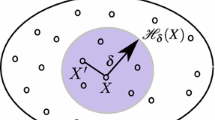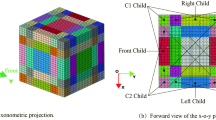Abstract
In this study, a 3-dimensional (3D) implementation of representative volume element homogenization using bond-based peridynamic formulation is presented. Periodic boundary condition is established by coupling the displacements of periodic point pairs. Homogenized (effective) material properties are obtained based on peridynamic displacement gradient tensor. The current approach is validated by considering a composite material without defects and comparing homogenized properties with results obtained from another homogenization approach. Next, the capability of the current approach is demonstrated by considering randomly generated cracks with arbitrary orientation and location. It can be concluded that the current approach can be an alternative approach to obtain 3-dimensional homogenized material properties for heterogeneous materials with defects.








Similar content being viewed by others
REFERENCES
Swan, C.C. and Kosaka, I., Voigt–Reuss Topology Optimization for Structures with Linear Elastic Material Behaviours, Int. J. Numer. Meth. Eng., 1997, vol. 40, no. 16, pp. 3033–3057. https://doi.org/10.1002/(SICI)1097-0207(19970830)40:16<3033::AID-NME196>3.0.CO;2-Z
Hill, R., The Elastic Behaviour of a Crystalline Aggregate, Proc. Phys. Soc. A, 1952, vol. 65(5), p. 349.
Kalamkarov, A.L., Andrianov, I.V., and Danishevskyy, V.V., Asymptotic Homogenization of Composite Materials And Structures, Appl. Mech. Rev., 2009, vol. 62(3), p. 030802. https://doi.org/10.1115/1.3090830
Zi, G. and Belytschko, T., New Crack-Tip Elements for XFEM and Applications to Cohesive Cracks, Int. J. Numer. Meth. Eng., 2003, vol. 57, no. 15, pp. 2221–2240. https://doi.org/10.1002/nme.849
Silling, S.A., Reformulation of Elasticity Theory for Discontinuities and Long-Range Forces, J. Mech. Phys. Solids, 2000, vol. 48, no. 1, pp. 175–209. https://doi.org/10.1016/S0022-5096(99)00029-0
Madenci, E. and Oterkus, E., Peridynamic Theory and Its Applications, New York: Springer, 2014. https://doi.org/10.1007/978-1-4614-8465-3_2
Zhu, N., De Meo, D., and Oterkus, E., Modelling of Granular Fracture in Polycrystalline Materials Using Ordinary State-Based Peridynamics, Materials., 2016, vol. 9, no. 12, p. 977. https://doi.org/10.3390/ma9120977
Imachi, M., Tanaka, S., Ozdemir, M., Bui, T.Q., Oterkus, S., and Oterkus, E., Dynamic Crack Arrest Analysis by Ordinary State-Based Peridynamics, Int. J. Fract., 2020, vol. 221, no. 2, pp. 155–169. https://doi.org/10.1007/s10704-019-00416-3
Basoglu, M.F., Zerin, Z., Kefal, A., and Oterkus, E., A Computational Model of Peridynamic Theory for Deflecting Behavior of Crack Propagation with Micro-Cracks, Comput. Mater. Sci., 2019, vol. 162, pp. 33–46. https://doi.org/10.1016/j.commatsci.2019.02.032
Candaş, A., Oterkus, E., and İmrak, C.E., Dynamic Crack Propagation and Its Interaction with Micro-Cracks in an Impact Problem, J. Eng. Mater. Technol. Trans. ASME, 2021, vol. 143(1), p. 011003. https://doi.org/10.1115/1.4047746
Nguyen, C.T. and Oterkus, S., Peridynamics Formulation for Beam Structures to Predict Damage in Offshore Structures, Ocean Eng., 2019, vol. 173, pp. 244–267. https://doi.org/10.1016/j.oceaneng.2018.12.047
Yang, Z., Vazic, B., Diyaroglu, C., Oterkus, E., and Oterkus, S., A Kirchhoff Plate Formulation in a State-Based Peridynamic Framework, Math. Mech. Solids, 2020, vol. 25, no. 3, pp. 727–738.
Nguyen, C.T. and Oterkus, S., Peridynamics for the Thermomechanical Behavior of Shell Structures, Eng. Fract. Mech., 2019, vol. 219, p. 106623. https://doi.org/10.1016/j.engfracmec2019.106623
Madenci, E., Barut, A., and Phan, N., Peridynamic Unit Cell Homogenization for Thermoelastic Properties of Heterogeneous Microstructures with Defects, Compos. Struct., 2018, vol. 188, pp. 104–115. https://doi.org/10.1016/j.compstruct.2018.01.009
De Meo, D. and Oterkus, E., Finite Element Implementation of a Peridynamic Pitting Corrosion Damage Model, Ocean Eng., 2017, vol. 135, pp. 76–83. https://doi.org/10.1016/j.oceaneng.2017.03.002
Diyaroglu, C., Oterkus, S., Oterkus, E., and Madenci, E., Peridynamic Modeling of Diffusion by Using Finite-Element Analysis, IEEE Trans. Component. Packaging Manuf. Technol., 2017, vol. 7, no. 11, pp. 1823–1831. https://doi.org/10.1109/TCPMT.2017.2737522
Diyaroglu, C., Oterkus, S., Oterkus, E., Madenci, E., Han, S., and Hwang, Y., Peridynamic Wetness Approach for Moisture Concentration Analysis in Electronic Packages, Microelectron. Reliabil., 2017, vol. 70, pp. 103–111. https://doi.org/10.1016/j.microrel.2017.01.008
Breitenfeld, M.S., Geubelle, P.H., Weckner, O., and Silling, S.A., Non-Ordinary State-Based Peridynamic Analysis of Stationary Crack Problems, Comp. Meth. Appl. Mech. Eng., 2014, vol. 272, pp. 233–250. https://doi.org/10.1016/j.cma.2014.01.002
Yu, W. and Tang, T., Variational Asymptotic Method for Unit Cell Homogenization of Periodically Heterogeneous Materials, Int. J. Solids Struct., 2007, vol. 44, no. 11–12, pp. 3738–3755. https://doi.org/10.1016/j.ijsolstr.2006.10.020
ACKNOWLEDGMENTS
The authors would like to dedicate this study to Professor Siegfried Schmauder for his 65th birthday.
Author information
Authors and Affiliations
Corresponding author
Additional information
Translated from Fizicheskaya Mezomekhanika, 2021, Vol. 24, No. 5, pp. 45–51.
Rights and permissions
About this article
Cite this article
Xia, W., Oterkus, E. & Oterkus, S. 3-Dimensional Bond-Based Peridynamic Representative Volume Element Homogenization. Phys Mesomech 24, 541–547 (2021). https://doi.org/10.1134/S1029959921050052
Received:
Revised:
Accepted:
Published:
Issue Date:
DOI: https://doi.org/10.1134/S1029959921050052




